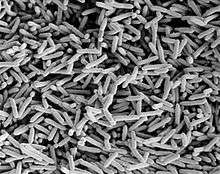Acetic acid bacteria
| Acetic acid bacteria | |
|---|---|
 | |
| Acetobacter aceti | |
| Scientific classification | |
| Kingdom: | Bacteria |
| Phylum: | Proteobacteria |
| Class: | Alphaproteobacteria |
| Order: | Rhodospirillales |
| Family: | Acetobacteraceae |
| Genera | |
|
Acetobacter | |
Acetic acid bacteria (AAB) are a group of Gram-negative bacteria which oxidize sugars or ethanol and produce acetic acid during fermentation.[1] The acetic acid bacteria consist of 10 genera in the family Acetobacteraceae.[1] Several species of acetic acid bacteria are used in industry for production of certain foods and chemicals.[1]
Characteristics
All acetic acid bacteria are rod-shaped and obligate aerobes.[1]
Occurrence
Acetic acid bacteria are airborne and are ubiquitous in nature. They are actively present in environments where ethanol is being formed as a result of fermentation of sugars. They can be isolated from the nectar of flowers and from damaged fruit. Other good sources are fresh apple cider and unpasteurized beer that has not been filter sterilized. In these liquids, they grow as a surface film due to their aerobic nature and active motility. Fruit flies or vinegar eels are considered as a common vector in propagating acetic acid bacteria.[2]
Suppression
The growth of Acetobacter in wine can be suppressed through effective sanitation, by complete exclusion of air from wine in storage, and by the use of moderate amounts of sulfur dioxide in the wine as a preservative.[3]
Metabolism
Vinegar is produced when acetic acid bacteria act on alcoholic beverages such as wine.
Some genera, such as Acetobacter, can oxidize ethanol to carbon dioxide and water using Krebs cycle enzymes. Other genera, such as Gluconobacter, do not oxidize ethanol, as they do not have a full set of Krebs cycle enzymes.
As these bacteria produce acid, they are usually acid-tolerant, growing well below pH 5.0, although the pH optimum for growth is 5.4-6.3.
One species of Acetobacter, Acetobacter xylinum, is able to synthesize cellulose,[4] something normally done only by plants.
References
- 1 2 3 4 Raspor P; Goranovic D (2008). "Biotechnological applications of acetic acid bacteria". Critical Reviews in Biotechnology. 28 (2): 101–124. doi:10.1080/07388550802046749. PMID 18568850.
- ↑ "Chapter 5". Vinegars of the World. ISBN 978-88-470-0865-6. Retrieved 28 May 2016.
- ↑ "Sulfur Dioxide: Science behind this anti-microbial, anti-oxidant". Practical Winery & Vineyard Journal. February 2009. p. 4. Retrieved 28 May 2016.
- ↑ "Formation of cellulose by certain species of Acetobacter" (PDF). Biochem J. 48 (5): 618–621. May 1951. doi:10.1042/bj0480618. PMC 1275385
 . Retrieved 28 May 2016.
. Retrieved 28 May 2016.
Further reading
- Ecological occurrence of Gluconacetobacter diazotrophicus and nitrogen-fixing Acetobacteraceae members: their possible role in plant growth promotion 2008. Microb Ecol. 55(1):130-40.
- Genera and species in acetic acid bacteria, 2008 Int. J. Food Microbiol. Volume 125, Issue 1, Pages 15–24.
- Polyphasic taxonomy of acetic acid bacteria: An overview of the currently applied methodology, 2008 Int. J. Food Microbiol. Volume 125, Issue 1, Pages 2–14
- Biotechnological applications of acetic acid bacteria, 2008, Critical Reviews in Biotechnology, Volume 28, Issue 2, 101-124
- Evaluation of viability and growth of Acetobacter senegalensis under different stress conditions, 2013 Int. J. Food Microbiol.Volume 163,issue 2-3, 204-213
External links
| Wikispecies has information related to: Acetobacteraceae |